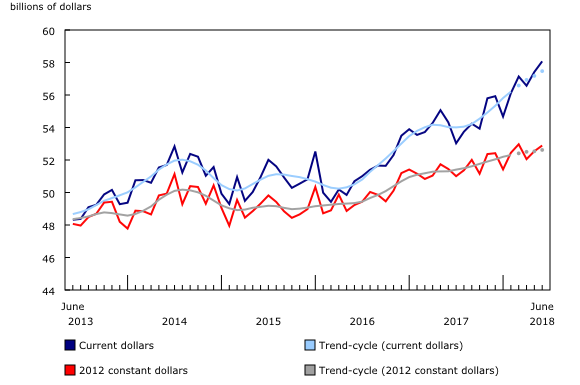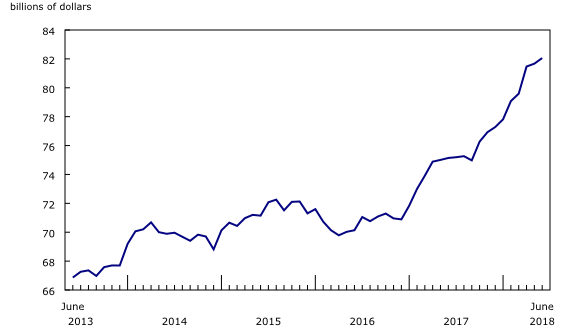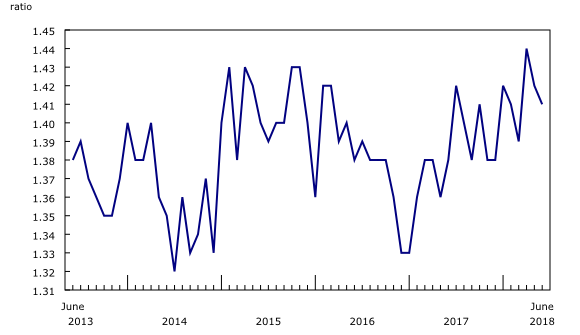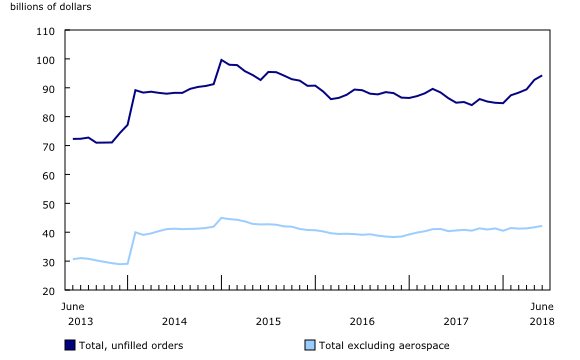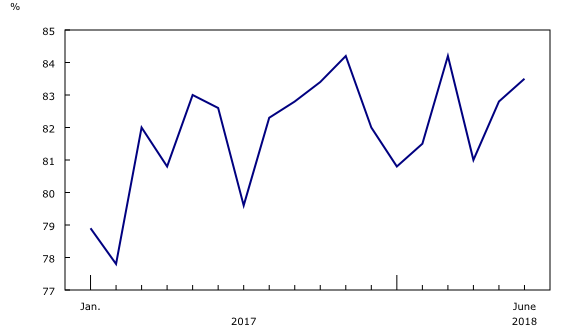Monthly Survey of Manufacturing, June 2018
Archived Content
Information identified as archived is provided for reference, research or recordkeeping purposes. It is not subject to the Government of Canada Web Standards and has not been altered or updated since it was archived. Please "contact us" to request a format other than those available.
Released: 2018-08-16
Manufacturing sales rose 1.1% to $58.1 billion in June, following a 1.5% increase in May. The increase in June was mainly due to sharply higher sales in the petroleum and coal product industry, while sales were down in the chemicals and food manufacturing industries.
In constant dollars, manufacturing sales were up 0.7%, indicating a higher volume of products sold.
Refinery production rebounds
Sales of petroleum and coal products increased 15.9% in June. Several major refineries ramped up production levels following temporary shutdowns and spring maintenance that began in April and continued into May. The production increase following the shutdowns was reflected in higher capacity utilization rates for the industry, which rose from 69.8% in May to 89.8% in June. Constant dollar sales in the industry were up 15.9% as well.
Sales also rose in the fabricated metal (+3.0%) and the plastics and rubber (+2.2%) product industries.
Widespread sales declines of pesticides and fertilizer products
Sales of chemical products were down 4.5% in June following two consecutive monthly increases. Despite the decrease in June, the sales of chemicals were still 2.2% higher year over year than in June 2017. The decline in the chemical product industry in June was concentrated in pesticides, fertilizers and other agricultural chemical product industry. This industry often posts significant growth in May and then declines in June following spring planting in the agricultural sector. This year, the decline in June was larger than previous years.
Sales of food products fell 1.7% to $8.8 billion in June following four consecutive monthly gains. The declines were widespread across most food manufacturing industries, led by the grains and oilseed milling industry. The decline in the grains and oilseed milling industry followed several months of higher sales.
Primary metal sales edged down 0.3% to $4.6 billion in June, following four consecutive monthly sales increases totalling 13.9% from January to May. Tariffs imposed by the United States on Canadian steel and aluminum products came into effect on June 1, 2018.
Sales up in five provinces
Manufacturing sales increased in five provinces in June, led by Quebec and Alberta.
Total manufacturing sales in Quebec rose 3.8% to $14.0 billion, while Alberta posted a 3.7% gain to $6.5 billion. The growth in both provinces was largely driven by higher production of petroleum and coal products following temporary shutdowns in April and May. In particular, sales of petroleum and coal products in Quebec rose 123.2% in June following declines in April and May. Production ramp-ups in Alberta refineries, which started in May, continued into June with sales increasing by 15.4%.
Ontario also contributed to the increase in manufacturing sales, rising 0.5% to $26.4 billion in June. The gain was largely due to higher sales of motor vehicles.
Sales in Saskatchewan fell 11.1% to $1.4 billion in June, following three consecutive monthly increases. Lower sales of pesticides, fertilizers and other agricultural chemical products were mostly responsible for the decline in the province.
Nova Scotia (-8.2%) posted the second largest provincial decrease in June, partly due to lower sales in the seafood product preparation and packaging industry.
Higher inventory levels
Total manufacturing inventories increased 0.5% to $82.1 billion in June, attributable to higher inventories in the petroleum and coal product (+6.3%) and the machinery (+1.7%) industries. Inventories of transportation equipment declined 1.2%.
The inventory-to-sales ratio decreased from 1.42 in May to 1.41 in June. The inventory-to-sales ratio measures the time, in months, that would be required to exhaust inventories if sales were to remain at their current level.
Unfilled orders increase
Unfilled orders rose for the fifth consecutive month, increasing 1.7% to $94.3 billion in June. The aerospace product and parts industry (+2.1%) was the main contributor to the gain, followed by the machinery (+5.0%) and the fabricated metal product (+3.5%) industries.
New orders decreased 1.8% in June following a 5.2% increase in May. The decline was mainly due to lower new orders in the aerospace product and parts industry in June compared with May.
Capacity utilization rates
The capacity utilization rate for the manufacturing sector rose from 82.8% in May to 83.5% in June. The largest increase was in the petroleum and coal industry as refineries ramped up production levels from 69.8% in May to 89.8% in June.
The capacity utilization rate in the chemical product manufacturing industry fell from 90.0% in May to 84.9% in June. The decline was partly attributable to lower production at fertilizer and pesticide manufacturing facilities in June.
Note to readers
Monthly data in this release are seasonally adjusted and are expressed in current dollars unless otherwise specified.
For information on seasonal adjustment, see Seasonally adjusted data – Frequently asked questions. For information on trend-cycle data, see Trend-cycle estimates – Frequently asked questions.
Non-durable goods industries include food, beverage and tobacco products, textile mills, textile product mills, clothing, leather and allied products, paper, printing and related support activities, petroleum and coal products, chemicals, and plastics and rubber products.
Durable goods industries include wood products, non-metallic mineral products, primary metals, fabricated metal products, machinery, computer and electronic products, electrical equipment, appliances and components, transportation equipment, furniture and related products, and miscellaneous manufacturing.
Production-based industries
For the aerospace and shipbuilding industries, the value of production is used instead of the value of sales of goods manufactured. The value of production is calculated by adjusting monthly sales of goods manufactured by the monthly change in inventories of goods in process and finished products manufactured. The value of production is used because of the extended period of time that it normally takes to manufacture products in these industries.
Unfilled orders are a stock of orders that will contribute to future sales assuming that the orders are not cancelled.
New orders are those received, whether sold in the current month or not. New orders are measured as the sum of sales for the current month plus the change in unfilled orders from the previous month to the current month.
Manufacturers reporting in US dollars
Some Canadian manufacturers report sales, inventories and unfilled orders in US dollars. These data are then converted to Canadian dollars as part of the data production cycle.
For sales, based on the assumption that they occur throughout the month, the average monthly exchange rate for the reference month established by the Bank of Canada is used for the conversion. The monthly average exchange rate is available in table 33-10-0163-01. Inventories and unfilled orders are reported at the end of the reference period. For most respondents, the daily average exchange rate on the last working day of the month is used for the conversion of these variables.
However, some manufacturers choose to report their data as of a day other than the last day of the month. In these instances, the daily average exchange rate on the day selected by the respondent is used. Note that because of exchange rate fluctuations, the daily average exchange rate on the day selected by the respondent can differ from both the exchange rate on the last working day of the month and the monthly average exchange rate. Daily average exchange rate data are available in table 33-10-0036-01.
Revision policy
Each month, the Monthly Survey of Manufacturing releases preliminary data for the reference month and revised data for the three previous months. Revisions are made to reflect new information provided by respondents and updates to administrative data.
Real-time data tables
Real-time data tables 16-10-0118-01, 16-10-0119-01 and 16-10-0014-01 will be updated on August 27.
Next release
Data from the Monthly Survey of Manufacturing for July will be released on September 18.
Contact information
For more information, or to enquire about the concepts, methods or data quality of this release, contact Javad Sadeghzadeh (613-698-7324; Javad.Sadeghzadeh@canada.ca) or Media Relations (613-951-4636; STATCAN.mediahotline-ligneinfomedias.STATCAN@canada.ca).
- Date modified:




